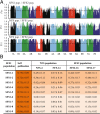Sympatric speciation of wild emmer wheat driven by ecology and chromosomal rearrangements
- PMID: 32123089
- PMCID: PMC7084162
- DOI: 10.1073/pnas.1920415117
Sympatric speciation of wild emmer wheat driven by ecology and chromosomal rearrangements
Abstract
In plants, the mechanism for ecological sympatric speciation (SS) is little known. Here, after ruling out the possibility of secondary contact, we show that wild emmer wheat, at the microclimatically divergent microsite of "Evolution Canyon" (EC), Mt. Carmel, Israel, underwent triple SS. Initially, it split following a bottleneck of an ancestral population, and further diversified to three isolated populations driven by disruptive ecological selection. Remarkably, two postzygotically isolated populations (SFS1 and SFS2) sympatrically branched within an area less than 30 m at the tropical hot and dry savannoid south-facing slope (SFS). A series of homozygous chromosomal rearrangements in the SFS1 population caused hybrid sterility with the SFS2 population. We demonstrate that these two populations developed divergent adaptive mechanisms against severe abiotic stresses on the tropical SFS. The SFS2 population evolved very early flowering, while the SFS1 population alternatively evolved a direct tolerance to irradiance by improved ROS scavenging activity that potentially accounts for its evolutionary fate with unstable chromosome status. Moreover, a third prezygotically isolated sympatric population adapted on the abutting temperate, humid, cool, and forested north-facing slope (NFS), separated by 250 m from the SFS wild emmer wheat populations. The NFS population evolved multiple resistant loci to fungal diseases, including powdery mildew and stripe rust. Our study illustrates how plants sympatrically adapt and speciate under disruptive ecological selection of abiotic and biotic stresses.
Keywords: Robertsonian translocation; abiotic stress; biotic stress; sympatric speciation; wild emmer wheat.
Conflict of interest statement
The authors declare no competing interest.
Figures





Similar articles
-
Natural selection causes adaptive genetic resistance in wild emmer wheat against powdery mildew at "Evolution Canyon" microsite, Mt. Carmel, Israel.PLoS One. 2015 Apr 9;10(4):e0122344. doi: 10.1371/journal.pone.0122344. eCollection 2015. PLoS One. 2015. PMID: 25856164 Free PMC article.
-
Genetic mapping of a novel powdery mildew resistance gene in wild emmer wheat from "Evolution Canyon" in Mt. Carmel Israel.Theor Appl Genet. 2021 Mar;134(3):909-921. doi: 10.1007/s00122-020-03741-7. Epub 2021 Jan 3. Theor Appl Genet. 2021. PMID: 33392708
-
Adaptive evolution of benzoxazinoids in wild emmer wheat, Triticum dicoccoides, at "Evolution Canyon", Mount Carmel, Israel.PLoS One. 2018 Feb 6;13(2):e0190424. doi: 10.1371/journal.pone.0190424. eCollection 2018. PLoS One. 2018. PMID: 29408917 Free PMC article.
-
Ecological genomics of natural plant populations: the Israeli perspective.Methods Mol Biol. 2009;513:321-44. doi: 10.1007/978-1-59745-427-8_17. Methods Mol Biol. 2009. PMID: 19347652 Review.
-
Evolution and Adaptation of Wild Emmer Wheat Populations to Biotic and Abiotic Stresses.Annu Rev Phytopathol. 2016 Aug 4;54:279-301. doi: 10.1146/annurev-phyto-080614-120254. Epub 2016 Jan 1. Annu Rev Phytopathol. 2016. PMID: 27296141 Review.
Cited by
-
Wheat genomic study for genetic improvement of traits in China.Sci China Life Sci. 2022 Sep;65(9):1718-1775. doi: 10.1007/s11427-022-2178-7. Epub 2022 Aug 24. Sci China Life Sci. 2022. PMID: 36018491 Review.
-
Rht12b, a widely used ancient allele of TaGA2oxA13, reduces plant height and enhances yield potential in wheat.Theor Appl Genet. 2023 Nov 21;136(12):253. doi: 10.1007/s00122-023-04502-y. Theor Appl Genet. 2023. PMID: 37989964
-
Identification of structural variations related to drought tolerance in wheat (Triticum aestivum L.).Theor Appl Genet. 2023 Mar 10;136(3):37. doi: 10.1007/s00122-023-04283-4. Theor Appl Genet. 2023. PMID: 36897407
-
Contribution of Duplicated Nucleotide-Binding Leucine-Rich Repeat (NLR) Genes to Wheat Disease Resistance.Plants (Basel). 2023 Jul 27;12(15):2794. doi: 10.3390/plants12152794. Plants (Basel). 2023. PMID: 37570947 Free PMC article. Review.
-
The Influence of Edaphic Factors on DNA Damage and Repair in Wild Wheat Triticum dicoccoides Körn. (Poaceae, Triticeae).Int J Mol Sci. 2023 Apr 6;24(7):6847. doi: 10.3390/ijms24076847. Int J Mol Sci. 2023. PMID: 37047823 Free PMC article.
References
-
- Mayr E., Systematics and the Origin of Species (Columbia classics in evolution series, Columbia University Press, New York, 1982), p. xxxvii, 334 pp.
-
- Coyne J. A., Orr H. A., Speciation (Sinauer Associates, Sunderland, Mass., 2004), p. vii.
-
- Dieckmann U., Doebeli M., On the origin of species by sympatric speciation. Nature 400, 354–357 (1999). - PubMed
-
- Filchak K. E., Roethele J. B., Feder J. L., Natural selection and sympatric divergence in the apple maggot Rhagoletis pomonella. Nature 407, 739–742 (2000). - PubMed
Publication types
MeSH terms
LinkOut - more resources
Full Text Sources

